Every day, millions of people log into Twitter to discover what’s happening around the world. Whether they’re sifting through headlines, engaging with their community or sharing pertinent news, Twitter is a tailored newsfeed for finding the latest news and content you want to read.
Did you know that on average:
- 9,100 tweets are sent every second (cool visualization)
- Translating to 546,000 tweets sent per minute
- Totaling 786,000,000 million sent every day (statisticbrain.com)
- Check out the real-time visualization of emojis on Twitter
How can marketers make sense of all of these tweets and find the right audience?
Savvy marketers can benefit from this unpredictable and dynamic platform by focusing on real-time trends, showcasing products/services to specific audiences and fostering deep connections with their audiences.
One way to drive results from Twitter Ads is to create a campaign targeting followers of certain usernames or handles. This type of campaign allows marketers to reach, engage and nurture targeted audiences beyond their own followers.
In this article, I’ll show you how to set up a Twitter campaign that targets followers of certain accounts, and I’ll provide you with six potential campaign targeting strategies.
How To Set Up A Twitter Campaign Targeting Followers
Twitter campaigns are straightforward to set up because they walk you through each step of the process. Like an AdWords campaign, the real challenge is determining your targeting and creative strategy. To get started, log in to ads.twitter.com and select your campaign objective. Ask yourself, “what is my goal and what do I want to optimize for?”
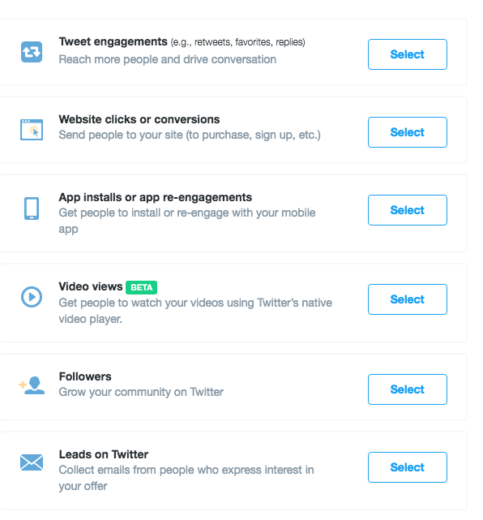
For this example, if I want to set up a direct response campaign for new website leads then I’ll pick optimize for “website clicks and conversions.” I didn’t choose Leads on Twitter because I want to drive people to the landing page to learn more about the product with the goal of requesting a product demo.
Step 1 – Set Up Your Campaign
Give your campaign a name. As a best practice make sure to name it so that other people will know exactly what you’re trying to accomplish just by glancing at it.

This is also when you can schedule a campaign launch and end dates, and select your conversion tag if you’re tracking and optimizing through Twitter.
Step 2 – Select Your Audience
Follower targeting is located under additional audience features just below “add keywords.” Start by typing in someone’s name or business name. This is a great way to create custom audience segments that are relevant to your business.
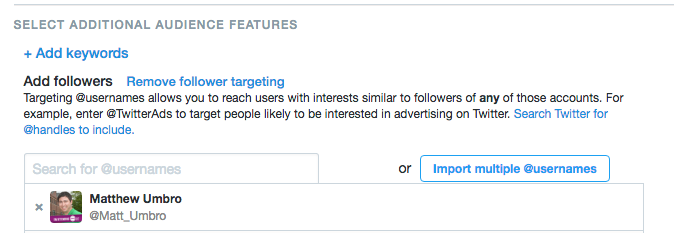
After inputting a few usernames, check your potential audience size. In this case, Twitter recommends that I add a few more @usernames to get within the recommended range.
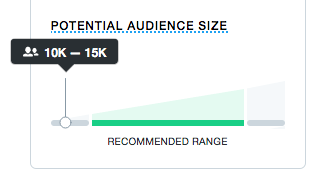
Still not sure who else you should be targeting to increase your audience size? You’re in luck. Thankfully, Twitter provides a list of recommended @usernames for you to consider.
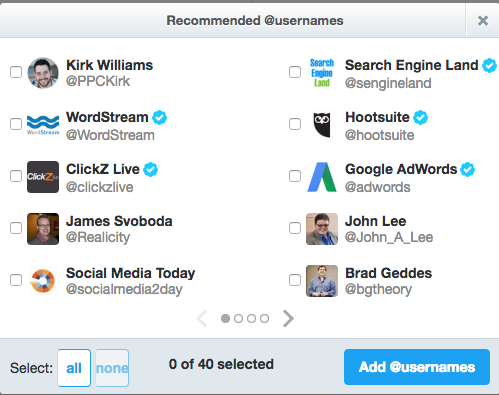
From here, you can add all 40 @usernames, or curate the top recommended usernames to target. If I add all 40 @usernames my potential audience skyrockets from 10-15K to 16-23 million people, which puts me just to the right of center for the recommended audience size. Twitter suggests adjusting your targeting until you reach the recommended threshold of at least 50k users.
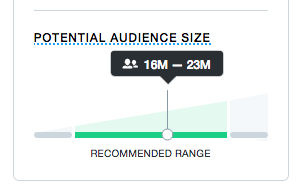
However, if I don’t want to target all of these users I can expand my original reach by targeting similar users. By default, this is added, as well as “target your followers,” so make sure to uncheck the boxes if you don’t want them included.

For those familiar with Facebook, this targeting is comparable to a “Lookalike Audience.” It’s useful if you want to expand your reach by adding similar people.
Step 3 – Set Your Budget
Next, add your daily max spend for the campaign. I also recommend adding in a total budget if you know the allocated amount of spend for the campaign — and to ensure that you don’t overspend.

Make your way down to “Choose Pricing.” From here you can let Twitter have full control of your bids with automatic bidding, or you can apply a max bid for each link clink.
If you select “max bid” then Twitter will recommend a bid based on what other advertisers are bidding. In this example, they recommend that we bid $3.08

Based on our bids and daily budget Twitter estimates we can reach 4K-5K people while generating 11-17 clicks per day. If I want to increase my reach, then I can increase my daily budget or raise my max bid.
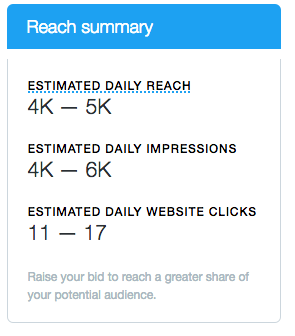
Step 4 – Choose Your Creatives
The last step is selecting or composing your tweets. Make sure your ads and CTA add value to the @usernames you’re targeting so you don’t appear spammy. Also, make sure that your ads are eye-catching.

If you’re looking for more tips, head over to Twitter’s blog where they reveal how to make your ads more effective.
6 Potential Twitter Follower Strategies
Below are six strategies you can experiment with for your next campaign.
- Target Influencers – Industry influencers typically have large, dedicated followers. Think popular bloggers, celebrities, musicians, journalists, athletes, actors, etc.. According to a recent Twitter report, “nearly 40% of Twitter users say they’ve made a purchase as a direct result of a Tweet from an influencer.” Also, 20% of respondents said they shared something they saw from an influencer. How can you tap into their audiences? Here’s an example of how a brand could target an influencer to drive sales. Puma (brand) might target Rickie Fowler’s (influencer) followers with ads about the Puma high top golf shoes that Rickie wears.

- Competitors – Get the attention of people who follow your competition. This is a great way to get your products and services in front of people by targeting businesses similar to yours. There’s typically less education since people are familiar with your competitor’s products so you can focus ads on your features and benefits and why it’s better than your competitors.
- Upstream and Downstream Brands – Target brands that complement yours. Think about possible businesses that sell products or services that come before or after yours. For example, Garmin could target the followers of popular running and cycling apparel companies who don’t yet sell GPS products.
- Media and News Outlets – Target specific publications or websites that your audience follow. Like influencers, these media companies often have dedicated followers who are interested in reading their content. If your content is similar, or you just want to get in front of this audience, try this strategy. Check out Socialbakers Twitter stats for your industry.
- Your Followers – With Twitter’s new curated feed, your audience may or may not see your tweet. While this has always been true, it doesn’t have to be. This could be a good choice if you want to promote a specific message or work on monetizing all those followers.
- Similar Audiences – Reach users with the same interests as the followers of account’s you’re targeting. With just a click, Twitter can help find and reach new audiences. This is especially useful if you’re looking to scale a campaign.
Conclusion
The targeting for this type of campaign isn’t perfect, as there are people you’ll target who want nothing to do with your brand or your product. However, with the right @username targeting and creative strategy, I’ve seen this type of campaign have great success. Once your target audience opts-in by clicking through to your website, you can leverage other channels and remarketing to push them down the funnel. For more Twitter success stories, click here.
Have you ever tried follower targeting with ads? What strategies do you have success with? Hit me up on Twitter @jdprater and let me know your thoughts.


